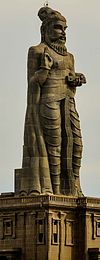Pari Perumal
Pari Perumal (c. 11th century CE), also known as Kaviperumal, was a
Biography
Pari Perumal hailed from Thenselhuvai in the Sethu country of the
Commentary on the Kural text
Pari Perumal chronologically came after Manakkudavar among the medieval commentators. In writing his commentary on the Kural, he greatly followed Manakkudavar, elaborating only where necessary. There are many places where he uses Manakkudavar's commentary verbatim. It can be said that Pari Perumal revised Manakkudavar's work. The semblance of his work with that of Manakkudavar includes an introduction to all the three books of the Kural text, an explanation to each subdivision (Iyal), introduction to each chapter, and the ordering of the couplets within each chapter.[4] Following Manakkudavar's original division, Pari Perumal also divides Book III of the Kural text into five iyals attributed to the moods of five thinais, or divisions of the Sangam landscape, namely kurinji (mountainous landscape), mullai (forest and pastoral landscape), marudam (agricultural plains and valleys), neidhal (coastal landscape), and paalai (desert landscape).[6] Nevertheless, Pari Perumal's explanations also differ from those of Manakkudavar in many places. For instance, his commentary varies from that of Manakkudavar in couplets 1081, 1178, and 1195. He also refers to other early commentators besides Manakkudavar in places such as couplets 480 and 1116.[4]
Like other medieval commentators, Pari Perumal had an extraordinary command of both
Pari Perumal was also well-versed in the Sanskrit works of
Pari Perumal also possessed excellent social and worldly knowledge. This is revealed in his explanations to couplets 522, 527, 529 and 530, where he describes the societal structure of his time.
Verses 1540 and 1541 of the Perunthogai indicate that Pari Perumal's commentary was not accepted by the masses during his time. Nevertheless, Pari Perumal hints that without a holistic understanding of the essence of the Tirukkural, one's effort to delve deep into the work would be fruitless.[4]
Variations in ordering of the Kural verses
The following table depicts the variations among the early commentators' ordering of, for example, the first ten verses of the Tirukkural. Note that the ordering of the verses and chapters as set by Parimelalhagar, which had been followed unanimously for centuries ever since, has now been accepted as the standard structure of the Kural text.
| Kural verse beginning | Couplet ordering | ||||
|---|---|---|---|---|---|
| Manakkudavar's | Pari Perumal's | Paridhi's | Kaalingar's | Parimelalhagar's | |
| Kural 1: அகர முதல எழுத்தெல்லாம் | 1 | 1 | 1 | 1 | 1 |
| Kural 2: கற்றதனால் ஆய பயன் | 2 | 2 | 2 | 2 | 2 |
| Kural 3: மலர்மிசை ஏகினான் மாணடி | 3 | 3 | 3 | 3 | 3 |
| Kural 4: வேண்டுதல் வேண்டாமை இலான் | 6 | 6 | 5 | 7 | 4 |
| Kural 5: இருள்சேர் இருவினையும் சேரா | 7 | 7 | 6 | 6 | 5 |
| Kural 6: பொறிவாயில் ஐந்தவித்தான் | 8 | 8 | 7 | 7 | 6 |
| Kural 7: தனக்கு உவமை இல்லாதான் | 4 | 4 | 6 | 4 | 7 |
| Kural 8: அற ஆழி அந்தணன் | 5 | 5 | 10 | 9 | 8 |
| Kural 9: கோளில் பொறியில் குணமிலவே | 10 | 10 | 8 | 5 | 9 |
| Kural 10: பிறவிப் பெருங்கடல் நீந்துவர் | 9 | 9 | 9 | 10 | 10 |
It is found that there are 16 variations found in the ordering of the Kural couplets by Pari Perumal with respect to the commentary by Manakkudavar. Thus, Pari Perumal's commentary remains the closest resembling work to the Manakkudavar commentary.
See also
Citations
- ^ Vedhanayagam, 2017, pp. 7–8.
- ^ Natarajan 2008, pp. 1–6.
- ^ Chellammal, 2015, p. 142.
- ^ a b c d e f g h i j k Aravindan, 2018, pp. 373–378.
- ^ Chellammal, 2015, pp. 142–143.
- ^ Meiyappan, 2003, p. vi.
- ^ a b Chellammal, 2015, pp. 146–147.
- ^ Chellammal, 2015, p. 147.
- ^ Chellammal, 2015, p. 146.
References
- M. V. Aravindan (2018). உரையாசிரியர்கள் [Commentators]. Chennai: Manivasagar Padhippagam.
- G. P. Chellammal (2015). திருக்குறள் ஆய்வுக் கோவை [Tirukkural Research Compendium] (in Tamil) (1 ed.). Chennai: Manivasagar Padhippagam.
- S. Meiyappan, ed. (2003). திருக்குறள் மணக்குடவர் உரை [Tirukkural: Manakkudavar Commentary] (in Tamil) (1st ed.). Chennai: Manivasagar Padhippagam.
- Natarajan, P. R. (December 2008). Thirukkural: Aratthuppaal (in Tamil) (First ed.). Chennai: Uma Padhippagam.
- Vedhanayagam, Rama (2017). திருவள்ளுவ மாலை மூலமும் எளிய உரை விளக்கமும் [Tiruvalluvamaalai: Moolamum Eliya Urai Vilakkamum] (in Tamil) (1 ed.). Chennai: Manimekalai Prasuram.
Further reading
- M. Arunachalam (2005). Tamil Ilakkiya Varalaru, Padhinaindhaam Nootraandu [History of Tamil Literature, 15th century].
- D. M. Vellaivaaranam (1983). Tirukkural Uraikotthu. Thiruppananthal Shri Kasimadam Publications.
- Casie Chetty, Simon (1859). The Tamil Plutarch, containing a summary account of the lives of poets and poetesses of Southern India and Ceylon. Jaffna: Ripley & Strong. p. 65.

